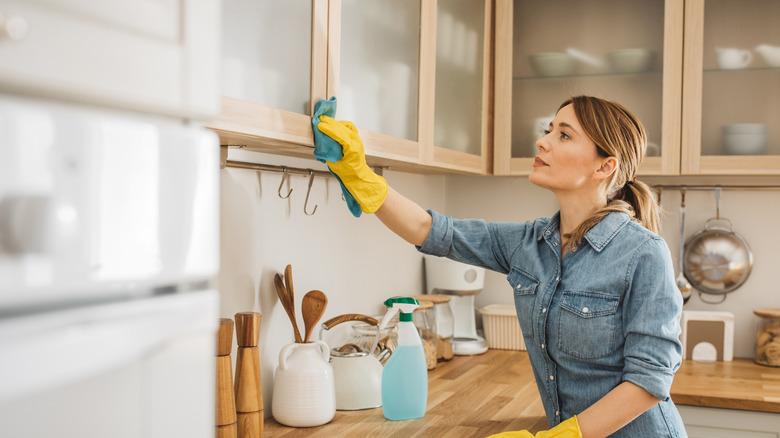How To Easily Clean Wooden Kitchen Cabinets To Bring Them Back To Life
We may receive a commission on purchases made from links.
Keeping our kitchen cabinets beautiful and looking new is a difficult task. Life happens in our kitchens: Cooking and food preparation is messy and filled with grit, grime, oil, spills, and splatters. Wooden cabinets and their finishes are especially vulnerable to the wear and tear of normal kitchen activity. As a professional woodworker who started his career making kitchen cabinets, keeping them in top condition is not only a problem I think about, but one I get asked about regularly. So, how should you approach this problem?
It is important to regularly clean your cabinets from the top to bottom, literally. Start with the uppers and move down to the lowers. Once or twice a year, take everything out of the cabinets and vacuum and wash the interior. It is not as time-consuming as it sounds and has many benefits. Inspect the interior for water damage, things like mold and insect or mouse infestations. (You may even "find" a beloved special dish you've forgotten!) Use warm water and dish soap and a soft cloth to do the job. A monthly thorough cleaning schedule is perfect, with weekly and daily touch-ups as needed. But, for a more down-to-the-bones clean, you'll need to know a little bit more about your cabinets and what types of cleaners are safe for wood. Read on to find out.
Keeping your wooden cabinets clean and shiny
Clear finishes like lacquer, oil-based polyurethane, traditional varnish, and water-borne polyurethane are tough and durable but can be harmed by harsh cleaners. Despite some influencers recommending it, I would never use vinegar on those finishes as its acidic nature can break down the finish, leaving your kitchen looking dated. Again, warm water and dish soap are perfect for this job. If you find a stubborn stain, try a nonabrasive product like Bar Keeper's Friend. Stay away from highly abrasive products or cleaning pads. Don't soak your wooden cabinets as you clean: Excess water can cause the wood to swell — instead, wipe them dry as you clean. Follow up with a protective product like Howard Feed N' Wax to bring back the original luster of the finish.
For wooden cabinets that are painted, you can use a more aggressive cleaner, but continue to stay away from abrasive products and pads. Paint formulations create a much harder surface (especially so in professionally built cabinets) than most clear finishes, so if you wish to use vinegar here, go at it with my blessing. To clean glass panels and hardware, use glass cleaner and general-purpose kitchen cleaning products respectively, employing a soft cloth. But, put the cleaner directly onto the cloth, not the hardware or glass. This will keep the harsh product away from the cabinet's finish. For most of us, our kitchens are a center of family activity, the main stage in our daily life, so to speak. Using these safe and effective cleaning techniques will keep your kitchen clean and welcoming.

